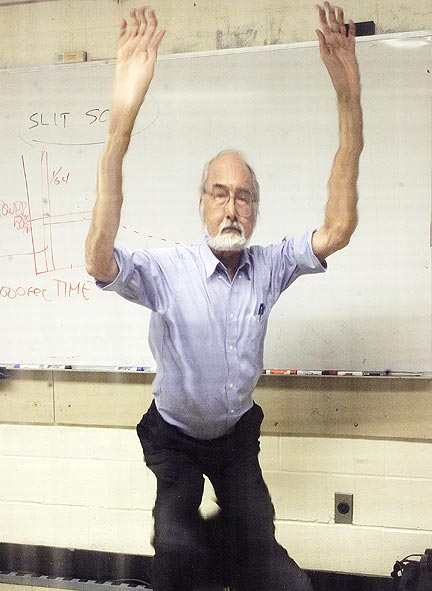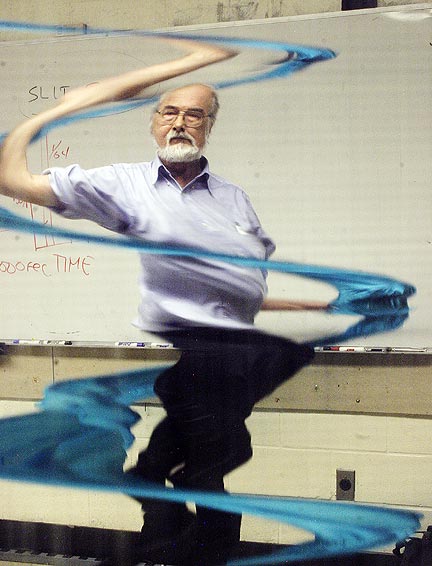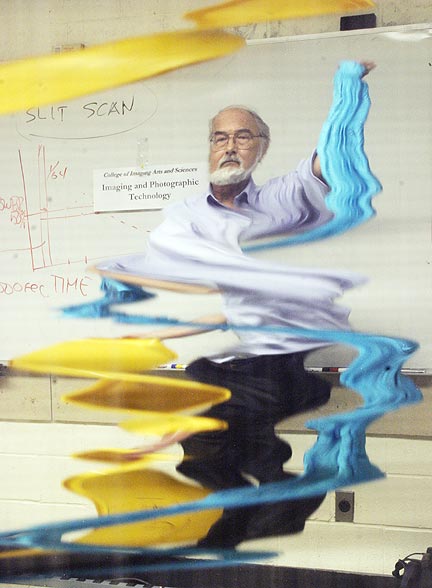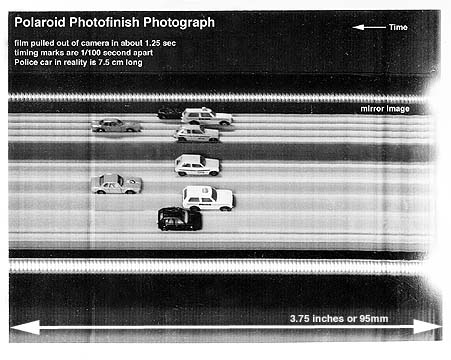|
Slit Scan and Strip Photography Overview
Andrew
Davidhazy
School of Photographic Arts and Sciences Rochester Institute of Technology What is popularly referred to as "slit scan" photography is more likely than not confused with various related but not identical methods of image recording. Slit scan is most closely related to the manner in which a focal plane shutter makes a record of a scene in a focal plane shutter equipped camera. The focal plane shutter in an idealized and basic form consists of a slit or slot that travels from one side of the image gate in a camera to the other. In early cameras the slots were cut into opaque "curtains" and the tension on the driving springs could be adjusted as well allowing the photographer to select from among a large number of exposure times. In modern cameras the rate at which the slot travels is kept constant but the size or width of the slot is adjusted depending on the exposure time that is set on the speed dial of the camera. A prime example of the focal plane shutter "effect" are the photographs shown below. A photographic "icon" is the image made by Henri Lartigue with probably a large format Graflex (or similar) camera of a race car that appears distorted and where also the spectators appear distorted or leaning at an impossible angle. Robert Doisneau, noted industrial photographer, also experimented with the technique and made the photograph of the intertwined couple probably with a large format camera in which the shutter slot rate f movement was slowed down giving time for the couple, standing on a turntable, to make a turn or two while the slot moved from the top of the frame to the bottom. ![[slitscan photo]](photofile-b/lartigue-1m.jpg) ![[slitscan photo]](photofile-b/doisneau-1m.jpg) ![[slitscan photo]](photofile-b/slitscan-1m.jpg) In my case the photograph was made in my special effects class years ago using a traveling slit scan box to which the camera was attached. It was made out of some wood, a pair of rollers, a high torque variable speed DC gear head motor, and some ancillary parts as described in another article at: http://people.rit.edu/andpph/text-slit-scan.html The color photographs ones below were made with a Canon Digital Rebel attached to the back of the same box while the shutter was held open for about 20 seconds or so giving time for the slit up front to move from top to bottom of the front of the box. OK - now where do we go from here? If you attach a video camera and do a recording looking into the "slit scan box" with a video or still camera that provides a video out all you will see is a traveling slot moving across a dark field. Now if you could accumulate the image of the moving slot one line at a time and display the resulting summation as the slot moves then you'd be able to see the resulting image "develop" on the screen ... filling up more and more of the frame. There is (or was) also a video converter or control box made by Colorado Video that does a similar function. It is called a Colorado Video 593 peak store device. It records any change in a field that rises above a set value - let's say black and displays the result continuously on the video out. In the digital realm the counterparts of the film based cameras using a slit to "scan" the image plan (like focal plane shutters) are called linear array focal plane scanning cameras. A prime example of such a recording system is the Better Light, http://www.betterlight.com, scanning back for large format cameras. Another method for recording a "slit scan" image is to obtain a digital camera that operates on the principle of a "rolling shutter" - the digital equivalent of a focal plane shutter. Most CMOS phone cameras for example have this kind of shutter built-in - but they move the area of sensitivity or "line" very quickly so they are not well suited to make distortions. Of course, animating or editing still frames is also an option. It is an option that some (many these days) people have "exploited". I believe one of the people who is a promoter of the method is the one who runs the following website and whose name is Bryan Mumford. and his web address is: http://www.bmumford.com/photo/camctlr.html Golan Levin put together an extensive list of people who photograph or make images based on either continuous recording or extraction of several lines fro each still frame of a video record and ultimate assembly into a final presentation. The list does not seem to discriminate between systems where the slit moves or where the recording surface moves. These are really different systems. One is best described as a "streak" system, another as a slit-scan system and the third as a strip system. In any case his list can be found here: http://www.flong.com/texts/lists/slit_scan/ To illustrate the difference between the moving slit method of creating images described above and other techniques erroneously "lumped in" with it these are the ones described below. These three or four recording methods or techniques are also generally (and in my opinion erroneously) also referred to as slit scan cameras generating slit scan photographs or simply called slit scan imaging systems. Unlike the moving slit approach described at the top of this article they depend on moving film (in the case of film cameras) past a stationary (usually) slit. The result of this approach is exemplified below in a record of the order of finish of racers at end of a race. This image is referred to as a photofinish photograph and it was made with what is commonly called a "strip" camera. These photographs are made by fixing the recording field of the camera to a narrow horizontal view by making the lens "look" through a narrow vertical slit and moving photosensitive material behind it as the images of the racers travel over the slit. An approximate match between image speed and recording material speed is desirable but not essential. The counterparts of these film-type photofinish cameras in the digital realm are called linear array strip scanning cameras and they have now pretty much replaced film-type photofinish cameras at most racetracks. Their recording rate is adjusted so that the resulting image of the racers appears more or less appropriate in terms of the aspect ration to the original. But the principle of operation is the same. Of course one could put the camera in motion relative to the subject. For example by placing it in a moving vehicle and causing the passing landscape or cityscape or row of parked cars to move over the slit in the camera or the linear array in a digital version. This variation might be called moving camera linear strip photograph. A typical result is as shown below:  Note that all space markers between cars are visible. This is of course a "real" impossibility for as the observer moves along the front of the cars the cars "hide" the markers located off to one side or the other of the observer. But the traveling strip camera records each of the markers as it passes in front of them. The same camera can be used to photograph any object that moves across the slit or linear array orientation. In this mode they are called "strip" cameras and they are used to photograph objects that put the subject features in motion by rotating the subject so it presents (for a 360 degree rotation) a different location on its surface to the recording system. These are called peripheral or rollout cameras. They can be used to photograph archeological specimens or humans as shown in the examples below:    A logical variation is to put the camera in rotational mode and in this case the camera is called a strip panoramic camera and will acquire a 360 degree panoramic record of the surrounding scene.   The alternative is to keep the slit fixed to some location and still move the recording surface or clock a digital linear array at some rate and then have the subject, remaining essentially stationary over the slit or moving along it leave a trace of its image position or size along the slit versus time. These systems are most often referred to as :"velocity recorders" or "time recorders". Most appropriately they essentially record image position versus time and do not produce images that look like the subject they photographed but rather deliver "streaks" that plot image displacement against time. They are the equivalent of strip chart recorders but use light instead of a pen to write on a moving surface. Much as lie detectors or seismographs or cardiac monitors work. These cameras or imaging systems can be used to time the duration of an event, velocity of the subject or whether events are simultaneous or not and if not then they provide timing error or discrepancy information. These cameras are still widely applied in fusion research to determine the timing and duration of laser pulses to a target area. In the illustration below such a camera is used to determine the velocity of 2 .22 caliber rifle bullets.  To demonstrate the power of these "streak" cameras used to determine simultaneity discrepancies in events that are supposed to be (or that are desirable) to be simultaneous consider the example below. Here a flash is slaved to another one and the difference in the time that the 2nd flash fires is off from the time that the first, or trigger, flash fires is shown to be about 25 microseconds or so. 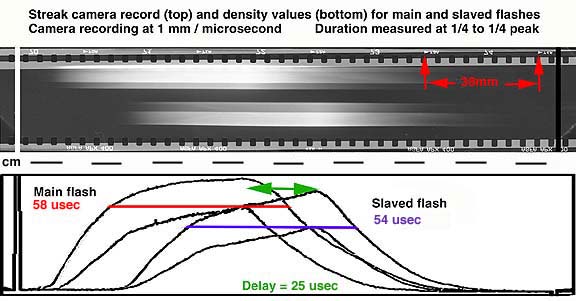 On the "visual" and possibly creative side the following illustrations also rely on looking at one line in space and having the subject, in this case some colored objects, rotation on a turntable so that their images would traverse the width of the slit on a regular basis. 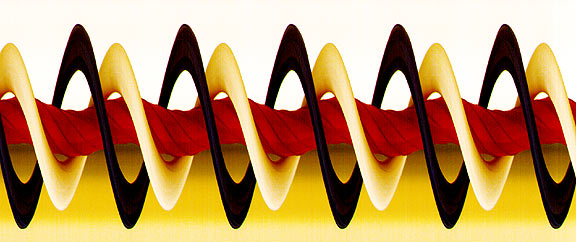 Finally both in the film realm and the digital one further variations can be achieved by moving the image of the subjects, the location of the slit within the camera and also the orientation of the camera. I don't have many examples of these variations but the one below should serve as an example. It demonstrates that during the time the model turned 180 degrees in front of the camera the camera itself panned across the field of view from one side of her head to the other. 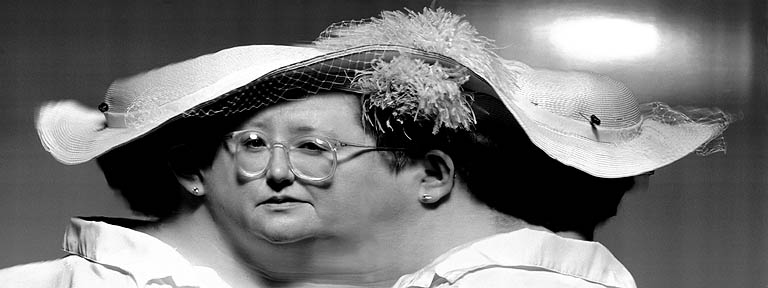 Now for a variation not often seen it is also possible to move the film in rotary fashion instead of linear fashion as in every example included above. This can also be accomplished with digital systems but it calls for a varying rate of image acquisition along the linear array. This results in the information from the linear array to be displayed as a part of a circle. The digital versions are beyond me but the film version is shown below as applied to the accurate peripheral record of a conical teapot and a panoramic record made with a strip panoramic camera where the axis of the camera was vertical but the camera's field of view was elevated. This is unlike linear strip panoramic records where the camera is adjusted to view at right angles to the rotation axis of the camera as shown above.    I am positive that there are many other variations possible on this theme. It is all about images being presented to the slit in a film type camera or to a linear array in a digital version of these cameras. The resulting images are all records of time as opposed to some physical dimension like width or length. These cameras include the time dimension as one of their dimensions and give up the 2nd dimension that is captured by most other standard types of cameras. These cameras are mostly about time and the relationship of of images that happen to pass by the slit of linear array over time. They are truly records of time itself. Amazing instruments don't you agree? If you
have any comments or observations to share you can reach me at:
Andrew Davidhazy, andpph@davidhazy.org |
